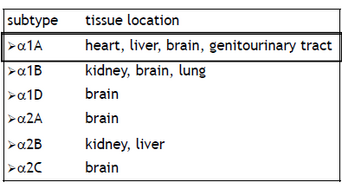Lecture Details[]
Elizabeth Davis; Week 6 MED1022; Pharmacology
Lecture Content[]
Cholinergic and adrenergic transmitters are the main ones in the ANS, some can be NANC e.g. NO. Co transmitters such as NO and ATP are important. ACh exists at sympathetic neuro-effector junctions. Cholinoceptors and adrenoceptors may both exist on tissues, receptors may be present even if nerves aren't (NA receptors in bronchial smooth muscle, ACh in vasculature). All except post ganglionic sympathetics are ACh (sympathetic cholinergics are present in a minority).
ACh acts on nicotinic or muscarinic receptors. Skeletal muscle, adrenal medulla and autonomic ganglia are nicotinic, parasympathetics, vascular endothelial cells and sympathetic cholinergics (sweat glands) are muscarinic. There are 5 subtypes (M1-5).
Nicotinic receptors have 5 subunits, can be alpha, beta, delta or gamma. ACh binds to alpha subunit, opens ion channel and lets Na enter and depolarisation spread. At ganglia and skeletal muscle, receptors are nicotinic. At the nerve-organ terminal and sympathetic cholinergics, transmission is muscarinic. Muscarinic receptors have M1, 4, 5 primarily in CNS and M2, 3 in CNS and peripheral tissues. Muscarinic receptors are GPCRs. M1 are neural receptors, found in CNS, peripheral neurons (ganglia and enteric nerves), gastric and salivary glands. It is involved in gastric acid secretion, salivation, CNS actions. M2 are cardiac receptors, found in atria and conducting tissue, smooth muscle and presynaptic terminals. Involved in cardiac inhibition, smooth muscle contraction and presynaptic inhibition. M3 are glandular/smooth muscle receptors, found in exocrine glands, smooth muscle, vascular endothelial cells. Involved in glandular secretion, smooth muscle contraction, vasodilation. M4 and 5 are largely not understood, confined to CNS. Associated with neurological disorders. Muscarinic activation decreases heart activity, increases tone and motility of GIT and relaxes sphincters, increases salivation, lacrimation and sweating as well as intestinal and bronchial secretion, there is pupil constriction and decreased accommodation and bronchoconstriciton.
Alpha adrenoreceptors are excitatory, beta are inhibitory except in the heart. Alpha are more potent to NA, less or equal adrenaline, and less isoprenaline. Vice versa for beta. a1 adrenoreceptors increase IP3 and DAG; a2 decrease cAMP, b adrenoreceptors increase cAMP. Subtypes may coexist, activation depends on potency and prevalence. a1 contracts vascular and genitourinary smooth muscle, induces gluconeogenesis in the liver and relaxes intestinal smooth muscle as well as mydriasis in the eye. a2 contract vascular smooth muscle, decrease transmitter release at presynaptic nerve terminals and increase platelet aggregation. Activation of presynaptic a2 decreases NA exocytosis.

b1 increase heart rate and force of contraction, increases renin secretion from kidney, increases production of aqueous humor in eye. b2 relaxes vascular smooth muscle, uterine smooth muscle, bronchial smooth muscle and increases glycogenolysis in the liver. b3 causes lipolysis of fat and relaxation of GI smooth muscle.